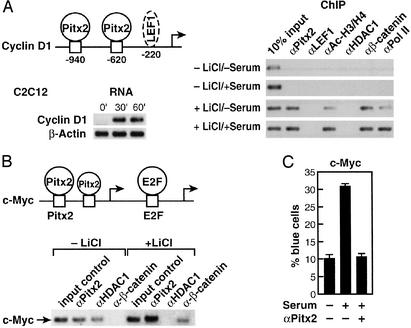Figure 1.
Pitx2 modulates a subset of G1 cell cycle control gene. (A) Recruitment of Pitx2, but not LEF1, to the murine Cyclin D1 promoter in C2C12 cells. A schematic of response elements is shown, with a potential (not proven) LEF1 site. Serum + LiCl caused rapid induction of Cyclin D1 transcripts by RT-PCR in C2C12 cells. A ChIP analysis reveals recruitment of Pitx2, but not LEF1, in response to LiCl treatment, even when we used primers out to −2 kb. (B) Pitx2 and β-catenin on the c-Myc promoter. Murine C2C12 myoblast cells were treated with lithium for 1 h in the presence of serum. ChIP assay was performed by using αPitx2, αHDAC1, and αβ-catenin-specific IgGs. In the absence of lithium, Pitx2 and HDAC1 were bound on the c-Myc promoter in C2C12 cells, whereas, after induction with lithium for 1 h, Pitx2 binding was stronger and release of HDAC1 and the presence of β-catenin were noted. PCR analysis was performed by using oligonucleotide primers flanking the Pitx2- and E2F-binding sites on the murine c-Myc promoter. Schematic shows the location of Pitx2 (−212; −188) and E2F (−154) elements. RT-PCR analysis was performed to check message level after treatment with lithium for 1 h. (C) Role of Pitx2 in c-Myc expression. C2C12 cells were microinjected with αPitx2 IgG and a c-Myc promoter carrying LacZ as a reporter. αPitx2 IgG inhibits the serum-dependent stimulation of the LacZ expression by 70%.

